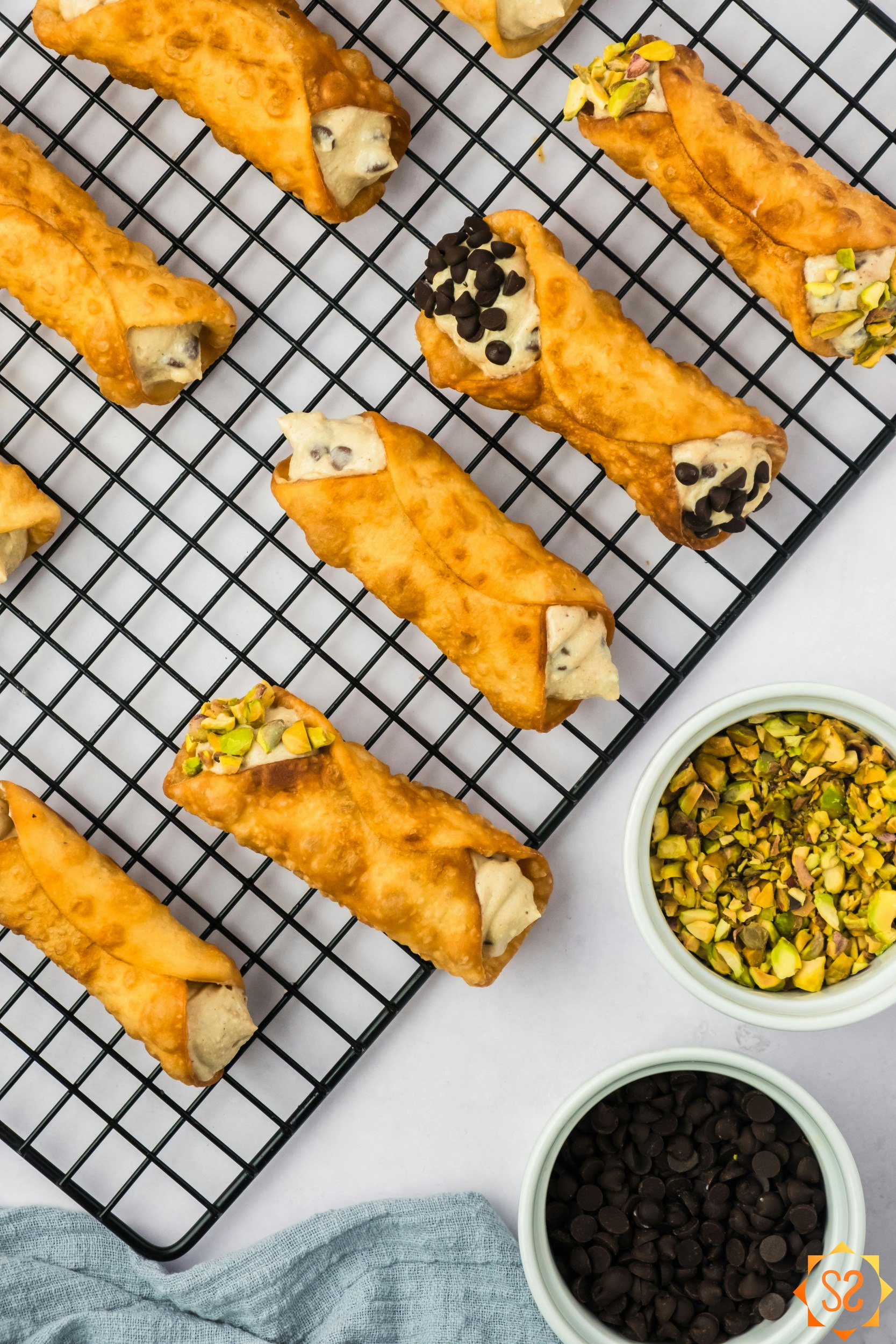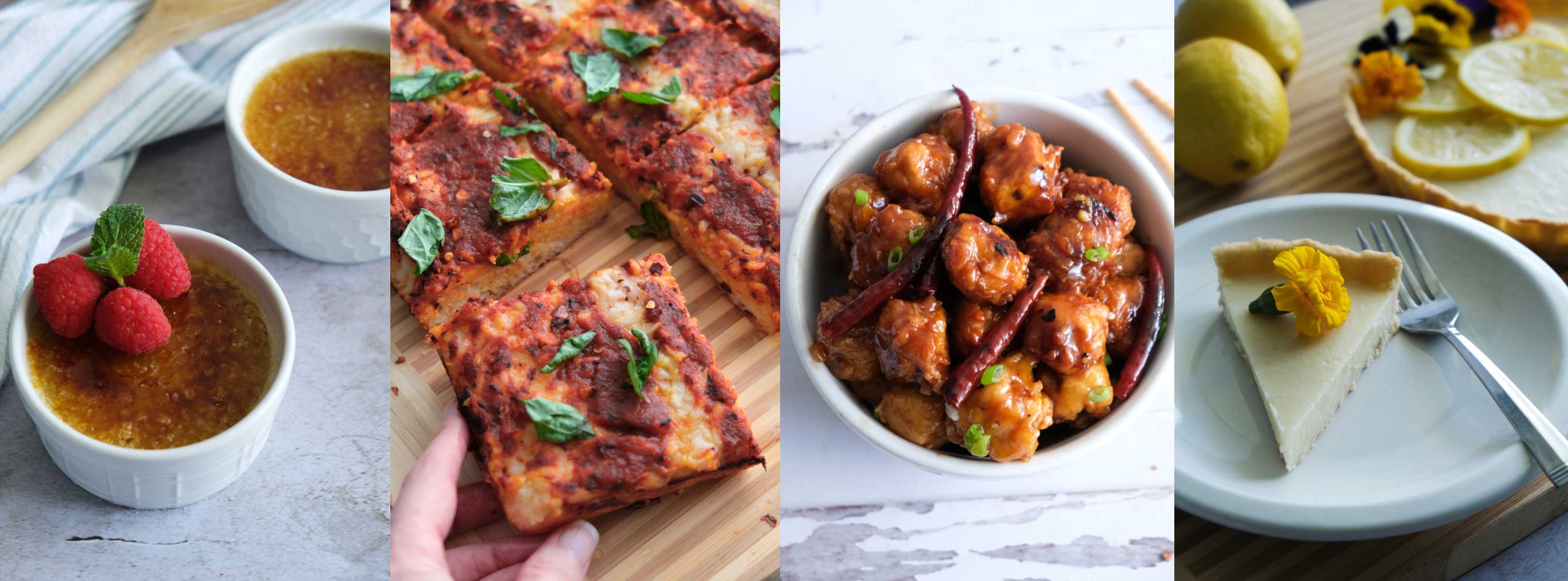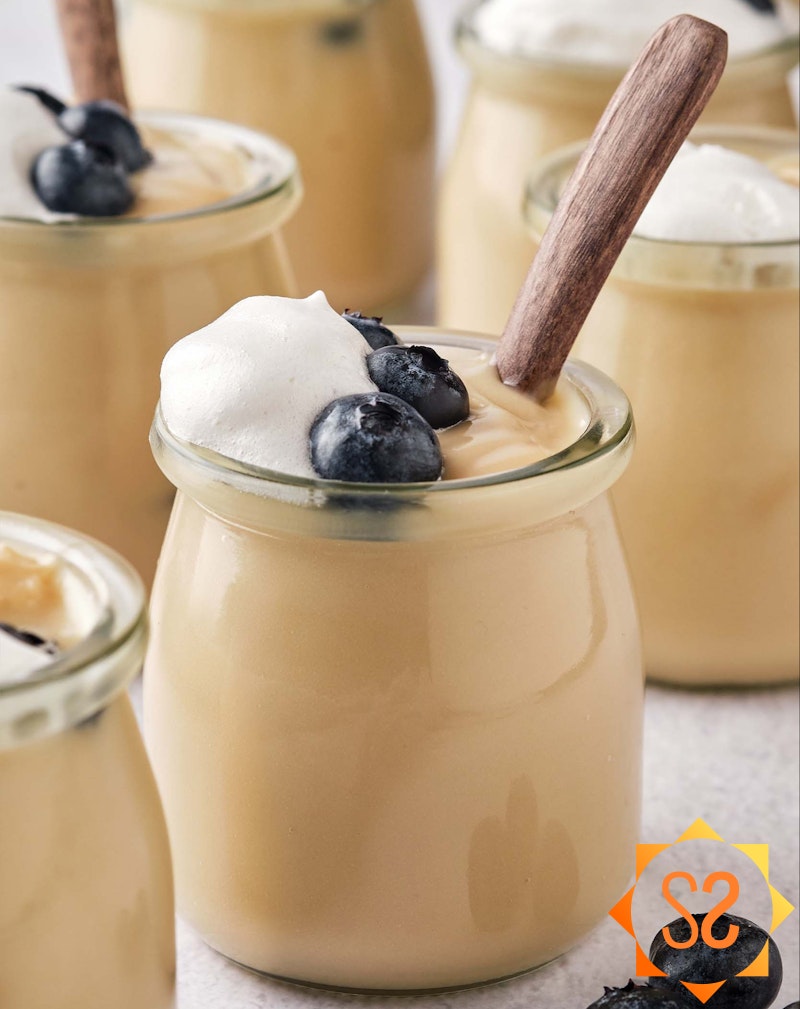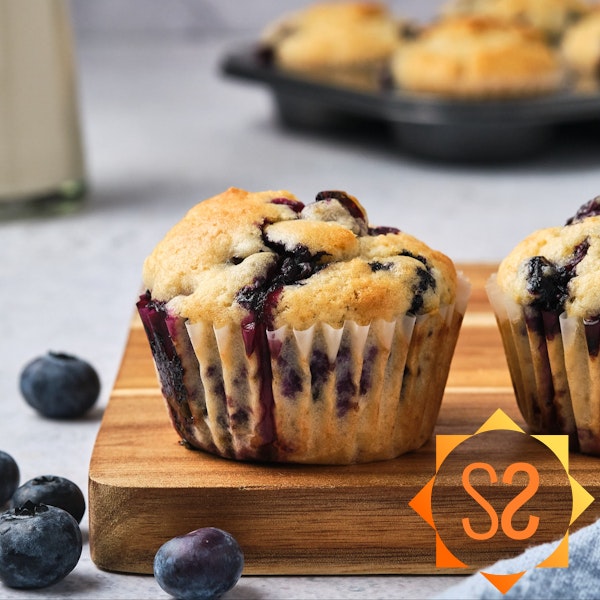Vegan Cannoli
Published: March 17, 2022
Modified: March 15, 2023
This vegan version of classic Sicilian cannoli is made with crispy, bubbly shells, and a cool, creamy non-dairy ricotta filling. Lightly sweet and fully crave-worthy, it's the perfect after-dinner treat. These vegan cannoli are also a good source of protein, thanks to the tofu base of the vegan ricotta.

What Sets This Vegan Cannoli Recipe Apart
If you've been searching for authentic vegan cannoli, this is your recipe. While there's a fair amount of work involved in this recipe, the result is absolutely worth the effort.
The light and crispy shells are made vegan with aquafaba and almond milk (my shell recipe is adapted from this Sicilian cannoli recipe from manggiabedda.com). I'm also using vegan Marsala wine to create the characteristic bubbles in the shell.
The filling uses a tofu ricotta base that's lightly sweetened and mixed in with vegan mini chocolate chips. (By the way, my tofu ricotta recipe is also great for savory meals, like lasagna or stuffed shells.) Some vegan cannoli recipes have a filling that resembles cake frosting more than ricotta, but I prefer this tofu ricotta filling which tastes more like the traditional version. The tofu filling also happens to be high in protein.

Special Equipment You'll Need
Making vegan cannoli does require some special tools and equipment. It's likely that you won't have everything you'll need to make this recipe laying around the kitchen. Here's a list for reference:
Cannoli tubes (forms): The most common cannoli tubes are made of stainless steel, but you may find other materials as well. Some people have made their own tubes, but for consistent shape and ease of use, I'd recommend picking up the ready-made forms. You should choose forms that are slightly longer than the cannoli you want to make.
Biscuit cutter: to cut the dough into large circles. You can also use another round cutter (such as the rim of a glass) I suggest using a cutter with a diameter that's slightly smaller than the length of your cannoli forms. So if you have 6-inch cannoli forms, try to find a 4.5 or 5-inch cutter.
Pastry/piping bag and large piping tip: You'll use this to pipe the filling into the shells. You can use a round or star-shaped piping tip, but I recommend using a large tip. If you don't have a piping bag and tip, you could also use a Ziploc freezer bag with a corner cut off. I wouldn't use a standard Ziploc bag, as it might not be strong enough to withstand the pressure of piping the filling.
Rolling pin: You'll want to roll out the dough very thin (1.5 mm or 1/16"), so be sure you have a good rolling pin. A pasta maker would also work to roll the dough.
Blender: You'll need to blend your tofu with other ingredients to make the vegan ricotta filling. You could also use a food processor for this.
Large saute pan or small pot: for frying the cannoli shells.
Mixing bowls: for mixing the dough and filling.
Tongs: for placing the cannoli shells in the hot oil and removing them.
Wire rack: for cooling the cannoli shells and draining the oil.

Ingredients & Substitutions

For the Cannoli Shells
Peanut oil: This is a good, neutral oil with a high smoke point that's also not too expensive. You could also use canola oil, safflower oil, or sunflower oil, but I don't recommend using vegetable (soybean) oil, because you'll taste the flavor of the oil in the shells.
All-purpose flour: for best results use the metric (grams) measurement instead of cups.
Granulated sugar: In the US, not all sugar is vegan. Some sugar is filtered with animal bone char. If you're in the US, buying organic sugar is a good way to ensure your sugar is vegan. You can also check with the manufacturer.
Salt: A small amount of salt helps bring out the flavors in sweet recipes like this one.
Marsala wine: A traditional ingredient in Sicilian cannoli shells, Marsala wine helps create the signature bubbles in the shells. However, not all wine is vegan. If you want to find a brand of vegan Marsala, Barnivore.com is a good resource. If you can't find vegan Marsala, you can also try another vegan sweet red wine.
Aquafaba: Aquafaba is used twice in the shells; once mixed into the dough and again to seal the shells before frying. In the dough, the aquafaba replaces the egg to help bind the dough together. Aquafaba is the best egg replacer for light and airy dough recipes like this one because aquafaba is very light itself. To seal the edges of the cannoli shells, I also recommend using aquafaba. I tried sealing the shells with water, aquafaba, and almond milk. The aquafaba was the most reliable and gave me the best result; the shells never came apart while frying. The water and almond milk worked most of the time, but did come apart a few times while frying.
Almond milk: Be sure you're using a plain, unsweetened variety. Other types of non-dairy milk (like cashew milk or oat milk) will work as well.
Sunflower oil: To provide fat for the dough. Other vegetable oils also work here.
For the Cannoli Filling and Garnish
Firm or extra-firm tofu: Be sure not to use silken tofu, as it won't produce the right texture. For this recipe, you'll want to squeeze out a little bit of water, but don't press the tofu.
Lemon juice: I recommend using freshly squeezed lemon juice for the best flavor.
Nutritional yeast: Adds a mildly cheesy flavor to our vegan ricotta.
Salt: A small amount of salt brings out the rich flavors in sweet recipes.
Ground cinnamon: Adds flavor to the filling.
Powdered sugar: Also known as icing sugar or confectioner's sugar. If you're in the US, you'll need to make sure that your sugar is vegan, as many brands process their sugar using animal bone char. Buying organic is a good way to ensure your sugar is vegan, or you can check with the manufacturer. If you don't have powdered sugar, you can blend granulated sugar with cornstarch in the blender until it reaches a powdered consistency. Use 1 tablespoon of cornstarch for each cup of sugar.
Mini chocolate chips: Optional, for the filling and garnish. Vegan mini chocolate chips can be difficult to find in stores, especially if you're looking for fair-trade-certified chocolate. Enjoy Life has vegan mini chocolate chips, but they're not fair trade. I was able to find fair trade vegan mini chocolate chips online from Hu Kitchen and nuts.com. If you don't want to order online or don't have time to wait, you can also chop up a bar of vegan dark chocolate.
Roasted pistachios: Optional, for garnish.
How to Store Your Homemade Vegan Cannoli
If you're not planning to eat all your cannoli at once, I recommend only filling the shells that you'll eat right away. If you do have pre-filled cannoli shells left over, you can store them in an airtight container in the refrigerator, but the shells will lose their crispness pretty quickly.
If possible, store your shells and filling separately. Your shells will keep best in a dry location at room temperature in an air-tight container. They'll taste best in the first 1-2 days, but they'll still be okay to eat for another day or two after that.
Store your filling in the refrigerator in an airtight container. It should last 3-4 days or longer in the refrigerator.

More Amazing Vegan Dessert Recipes
Want more sweet treats? Check out my entire list of vegan desserts, or try one of the recipes below:
Frequently Asked Questions
Why are my cannoli shells soft? If you haven't rolled out your cannoli dough thin enough, your cannoli shells might have a soft texture instead of a crispy one. Your dough should be rolled out as thin as possible to get a nice crunchy shell. It's also possible that your oil was not hot enough when you fried the shells. Your shells should be turning golden in around 30 seconds or less.
Can I skip the cooking wine? It's not entirely necessary to use Marsala wine, however it is part of the traditional recipe and it creates bubbles in the cannoli shells.
Is Marsala wine vegan? Not all brands of Marsala wine are vegan, so please check! Barnivore.com has a searchable database of wine and liquor that you can check, and they do their own research by contacting the companies directly to confirm whether their products are vegan. Lombardo is one popular brand of Marsala that is listed as vegan on their site. Colombo also makes a vegan Marsala that you may be able to find locally.
What type of frying oil should I use? I like peanut oil for frying, but you can use anything with a neutral flavor and high smoke point. Canola oil, safflower oil, and sunflower oil will work. I don't recommend using vegetable oil (soybean oil) because it doesn't have a neutral flavor.
What if I have leftover filling? This recipe should make just enough filling to fill the shells. However, your mileage may vary depending on how tightly you wrap the shells around the forms. So if you have filling left over, you can use it as cannoli dip! Get some vegan waffle cones, break them up, and enjoy!

Vegan Cannoli
Yield10 cannoli
Prep Time40 minutes
Cook Time10 minutes
Total Time50 minutes
Ingredients
- peanut oil, or another neutral oil for frying
Cannoli Dough
- 3/4 cup plus 2 tbsp. all-purpose flour
- 1/2 tbsp. vegan granulated sugar
- 1/8 tsp. salt
- 2 tbsp. vegan Marsala wine
- 1 1/2 tbsp. aquafaba (liquid from a can of chickpeas)
- 1 1/2 tbsp. plain, unsweetened almond milk (or other non-dairy milk)
- 1/2 tbsp. sunflower oil (or other vegetable oil)
- additional aquafaba, for sealing the shells
Vegan Ricotta Filling
- 1 14-oz. package firm or extra-firm tofu
- 2 tsp. freshly squeezed lemon juice
- 3 tbsp. nutritional yeast
- 3/4 tsp. salt
- 1/4 tsp. ground cinnamon
- 3/4 cup vegan powdered (icing/confectioner's) sugar
- 1/4 cup vegan mini chocolate chips (optional)
Garnish
- vegan powdered (icing/confectioner's) sugar, for dusting
- roasted pistachios, crushed
- vegan mini chocolate chips
Instructions
Add flour, granulated sugar, and 1/8 tsp. salt to a small mixing bowl and mix well. To another small bowl, add Marsala wine, 1 1/2 tbsp. aquafaba, almond milk, and sunflower oil and mix. Add the wet ingredients to the dry ingredients and mix well with a fork or fingers to form a dough.
![Vegan cannoli shell dough, just formed, in a mixing bowl.]()
Turn the dough out onto a floured work surface and knead the dough until it’s smooth, about 5 minutes. If the dough is too sticky to knead, you can add a little flour, but don’t add too much. (The more flour you add, the harder it will be to roll out).
![Vegan cannoli dough on parchment, after being kneaded]()
Heat about 2 inches of oil in a saute pan or small pot over medium heat. On the counter near the pan, lay out some paper towels underneath a wire cooling rack.
Divide your dough into two balls, and use a rolling pin to roll the first one out very thin, about 1/16” (1.5 mm) thick. Use a large biscuit cutter (or the edge of a glass) to cut circles from the dough. You should use a cutter that’s a bit smaller than your cannoli forms.
![A ball of dough next to rolled out dough, with a rolling pin to the side, and a round cutter on top; one round piece of dough has already been cut.]()
Repeat with the second ball of dough until all the dough has been used up. You can reroll the scraps of dough if needed.
Place a cannoli form on top of your dough circle and wrap the edges of the dough around the form. I usually wrap them loosely so that they’re easier to take off after they’re cooked. Brush some aquafaba on the edges of the dough and press to seal. (Be sure to press well, as you don’t want the edges to come apart during frying).
![Cannoli dough cut and placed on forms.]() Wrap your dough loosely around the forms; this will make the shells easier to remove and also create more space inside the shells for filling.
Wrap your dough loosely around the forms; this will make the shells easier to remove and also create more space inside the shells for filling.Use tongs to place one or more cannoli in the hot oil (leave enough room for them to move around). Fry until golden and bubbly (about 30 seconds), then use the tongs to turn the cannoli over and fry the other side. Remove from the oil with the tongs, let the excess oil drip off into the pan, then place on the wire rack to cool and drain.
![A finished cannolo shell coming out of the pan.]() Caution: Use trivets or other heat-safe pads before placing hot pans on countertop.
Caution: Use trivets or other heat-safe pads before placing hot pans on countertop.Once they’re cool enough to handle, gently pull the cannoli from the forms. (If you want to remove the cannoli from the forms while they’re still hot, protect your hands with clean kitchen towels or oven mitts).
Prepare your filling: Squeeze your tofu slightly to remove excess water (don’t press it, you’ll want to retain some of the water). Then break it up and add it to a blender or food processor. Add in lemon juice, nutritional yeast, salt, and cinnamon, and blend until smooth. Add in the powdered sugar, 1/4 cup at a time, until you’ve reached the desired sweetness. (I used 1/2 cup).
Transfer the tofu ricotta filling to a large bowl and stir in mini chocolate chips, if desired.
![A bowl of finished tofu ricotta filling next to a wire rack of cannoli shells.]()
Prepare a pastry bag with a large round or star tip and fill it with your filling mixture, leaving enough room at the top to twist the bag closed. Use a twist tie to close the bag, then pipe the filling into your shells. You can fill half of the shell from one side, then turn the shell around and fill the other side.
![Cannoli shells on a wire rack, some with filling piped in, and a piping bag to the side.]()
Dip the ends of the cannoli in crushed pistachios or mini chocolate chips, if desired. Dust with some vegan powdered sugar, and enjoy!
![Vegan cannoli with crushed pistachios and mini chocolate chips being added as garnish.]()
Notes & Hints
Make sure your dough is rolled very thin. If it's not thin enough, you'll end up with soft shells.
You could also seal the shells with water or almond milk, but I found that the aquafaba has the best holding power.
If you removed too much water from your tofu and can't get a smooth consistency in the blender, you can always add some water or almond milk 1/2 tbsp. at a time to get a smoother consistency.
Be cautious adding powdered sugar; the more powdered sugar you add to your ricotta, the thinner it will get.
Only fill as many shells as you'll eat right away. For the leftovers, store the shells in an airtight container at room temperature; the filling in the refrigerator.
Some wines are filtered using animal products. Check the post above for suggestions on finding a vegan Marsala wine.
Nutrition Data
Serving Size: 1/10 of recipe; Calories: 180; Fat: 6 g.; Saturated Fat: 2 g.; Cholesterol: 0 mg.; Sodium: 198 mg.; Carbohydrates: 25 g.; Fiber: 1 g.; Sugar: 13 g.; Protein: 7 g.; Vitamin A: 1 mcg. RAE; Vitamin B12: 2 mcg.; Vitamin C: 0 mg.; Vitamin D: 0 mcg.; Calcium: 39 mg.; Iron: 1 mg.; Potassium: 118 mg.; Zinc: 0 mg.Note: This data should be used only as an estimate. Please see the nutrition section of my terms and conditions for more information on how this data is calculated.
Vegan recipes in your inbox
Join the community and get my newest and best yummy vegan recipes sent right to your email!

Share this:


























Leave a Comment
I love reading comments! I'll do my best to answer questions, too. If you made the recipe, please leave a star rating, it helps support the blog so I can make more recipes and articles. Thank you!
says